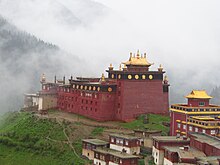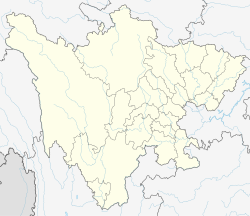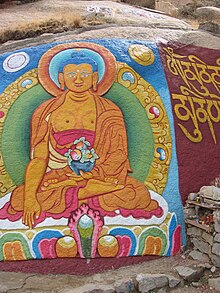A tulku is a distinctive and significant aspect of Tibetan Buddhism, embodying the concept of enlightened beings taking corporeal forms to continue the lineage of specific teachings. The term "tulku" has its origins in the Tibetan word "sprul sku", which originally referred to an emperor or ruler taking human form on Earth, signifying a divine incarnation. Over time, this term evolved within Tibetan Buddhism to denote the corporeal existence of highly accomplished Buddhist masters whose purpose is to ensure the preservation and transmission of a particular lineage.
There are currently two, separately enthroned 17th Gyalwang Karmapas: Ogyen Trinley Dorje and Trinley Thaye Dorje. The Karmapa is the spiritual leader of the nine-hundred-year-old Karma Kagyu lineage of the Kagyu school of Tibetan Buddhism.
Tai Situpa is one of the oldest lineages of tulkus in the Kagyu school of Tibetan Buddhism In Tibetan Buddhism tradition, Kenting Tai Situpa is considered as emanation of Bodhisattva Maitreya and Guru Padmasambhava and who has been incarnated numerous times as Indian and Tibetan yogis since the time of the historical Buddha.

Chöje Akong Tulku Rinpoche was a tulku in the Kagyu school of Tibetan Buddhism and co-founder of the Samye Ling Monastery in Scotland, Tara Rokpa Therapy & ROKPA International Charity.

Thrangu Rinpoche was born in Kham, Tibet. He was deemed to be a prominent tulku in the Kagyu school of Tibetan Buddhism, the ninth reincarnation in his particular line. His full name and title was the Very Venerable Ninth Khenchen Thrangu Tulku, Karma Lodrö Lungrik Maway Senge. The academic title Khenchen denotes great scholarly accomplishment, and the term Rinpoche is a Tibetan devotional title which may be accorded to respected teachers and exemplars.

The sixteenth Gyalwa Karmapa, Rangjung Rigpe Dorje was the spiritual leader of the Karma Kagyu lineage of Tibetan Buddhism. Followers believed him to be part of the oldest line of reincarnate lamas in Vajrayana Buddhism, known as the Karmapas, whose coming was predicted by the Buddha in the Samadhiraja Sutra. The 16th Karmapa was considered to be a "living Buddha" and was deeply involved in the transmission of the Vajrayana Buddhism to Europe and North America following the Chinese invasion of Tibet. He had many monikers, including "King of the Yogis", and is the subject of numerous books and films.

Kalu Rinpoche was a Buddhist lama, meditation master, scholar and teacher. He was one of the first Tibetan masters to teach in the West.

Jamgön Kongtrül Lodrö Thayé, also known as Jamgön Kongtrül the Great, was a Tibetan Buddhist scholar, poet, artist, physician, tertön and polymath. He is credited as one of the founders of the Rimé movement (non-sectarian), compiling what is known as the "Five Great Treasuries". He achieved great renown as a scholar and writer, especially among the Nyingma and Kagyu lineages and composed over 90 volumes of Buddhist writing, including his magnum opus, The Treasury of Knowledge.
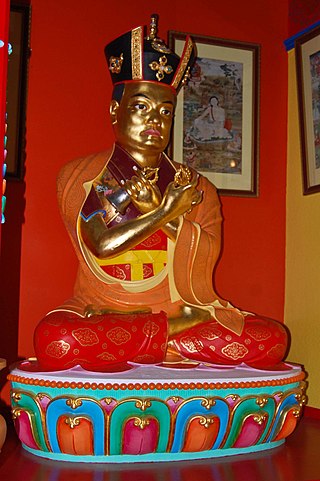
Karma Kagyu, or Kamtsang Kagyu, is a widely practiced and probably the second-largest lineage within the Kagyu school, one of the four major schools of Tibetan Buddhism. The lineage has long-standing monasteries in Tibet, China, Russia, Mongolia, India, Nepal and Bhutan, with current centres in over 60 countries. The spiritual head of the Karma Kagyu is the Gyalwa Karmapa; the 2nd among the 10 Karmapas had been the principal spiritual advisors to successive emperors of China. The Karma Kagyu are sometimes called the "Black Hat" lamas, in reference to the Black Crown worn by the Karmapa.

Tsurphu Monastery (Tibetan: མཚུར་ཕུ་དགོན་པ or Tölung Tsurphu is a gompa which serves as the traditional seat of the Karmapa, the head of the Karma Kagyu lineage of Tibetan Buddhism. It is located in Gurum in Doilungdêqên District, Tibet Autonomous Region, China, 70 kilometres from Lhasa.
Nenang Pawo is one of the highest lamas of the Karma Kagyu school of Tibetan Buddhism. The Pawos form a lineage of tulkus, of which the first was born in 1440. They were traditionally the heads of Nenang Monastery in Ü-Tsang.

Khenpo Karma Tharchin Rinpoche, widely known by his abbreviated name Khenpo Karthar Rinpoche, was a senior lama of the Karma Kagyu school of Tibetan Buddhism. Before his death he served as abbot of Karma Triyana Dharmachakra (KTD) Monastery in Woodstock, New York.

Pema Dönyö Nyinje is the 12th Tai Situpa, a tulku in Tibetan Buddhism, and one of the leading figures of the Karma Kagyu school. He is the head of Palpung Monastery.
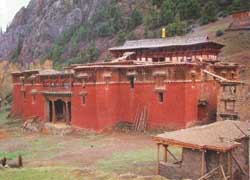
Karma Gon Monastery, the original monastery of the Karma Kagyu sect of Tibetan Buddhism, was founded in the 12th century by Düsum Khyenpa, the 1st Karmapa Lama in eastern Tibet at the age of 76. Karma Gon, is located on the eastern bank of the Dzachu River in Chamdo, eastern Tibet. Karma Dansa was the cradle of the karma kagyupas. When established the Karmapa had gathered 1000 monks around him here. Karma Gon was named as Karma Dansa as an administrative unit and the Chinese Ming Court enlarged the monastery’s jurisdiction by adding the Mekong’s middle and upper reaches. It was then also called Gama Dansa Si in Chinese.

Situ Panchen (1700–1774), full name Situ Panchen Chögyi Jungney, was the 8th Tai Situ Rinpoche. He was also an influential Tibetan painter, writer and medical innovator as well as a notable figure in the histories of Karma Kagyu and the Kingdom of Dêgê, where he served as senior court chaplain.

Chöje Lama Gelongma Palmo, ; * 1970 Sabine Januschke in Vienna is one of the few female Lamas of Buddhism and the first ever non Asian, female Chöje Lama.
The name Karma Chagme refers to a 17th-century Tibetan Buddhist (Vajrayāna) lama and to the tülku lineage which he initiated. Including the first, seven Karma Chagme tülkus have been recognized. The Neydo Kagyu sub-school of the Karma Kagyu was established by the first Karma Chagme, Rāga Asya.
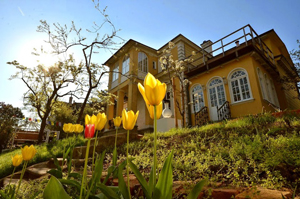
Palpung Europe, fully Palpung Yeshe Chökhor Ling Europe is the European Seat of the Palpung Congregation of H. H. Chamgon Kenting Tai Situ Rinpoche which was established by and is under the direction of Chöje Lama Palmo. The City Institute is based in the Viennese Forest in Purkersdorf, the Rural Institute lies in the Bohemian Forest in the border triangle of Austria, Germany and Czech Republique, in Langschlag.

Palpung Ireland is a Vajrayana Buddhist Centre with branches in Cork city and Banteer, County Cork. It is part of the Karma Kagyu tradition of Buddhism of which the supreme head is the 17th Galwa Karmapa, Ogyen Trinley Dorje. The director and spiritual head of Palpung Ireland is the Guru Vajradhara 12th Chamgon Kenting Tai Situ Pa Rinpoche. Palpung Ireland is a branch of the Palpung foundation based in Palpung Sherabling Monastery Monastic Seat in India with branches worldwide. Ani Choedrun Lhamo an Irish Buddhist nun is the resident teacher.

Although there were many householder-yogis in Tibet, monasticism was the foundation of Buddhism in Tibet. There were over 6,000 monasteries in Tibet. However, nearly all of these were ransacked and destroyed by Red Guards during the Cultural Revolution. Most of the major monasteries have been at least partially re-established, while many others remain in ruins.
